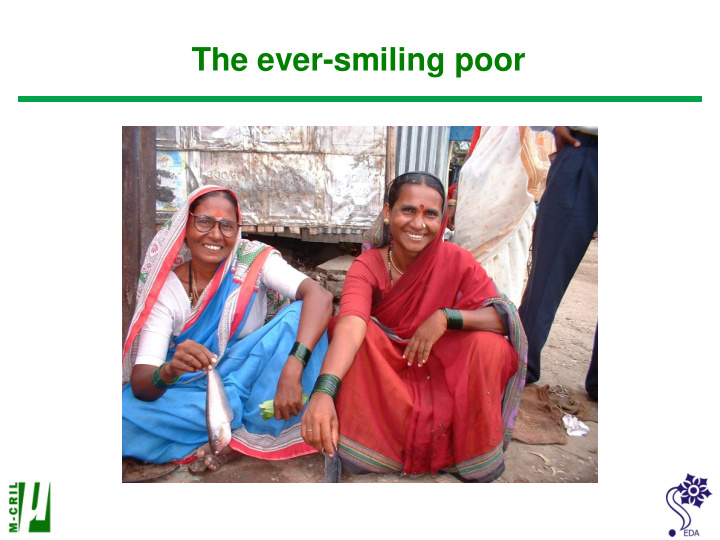



The ever-smiling poor
The Long March of BASIX and the Indian Microfinance Adventure BASIX’ Long March from Credit to Livelihood Services (The Livelihoods Triad) Savings and Credit Forum Bern, 11 May 2012 Malcolm Harper 602 Pacific Square, 32nd Milestone NH8, Gurgaon 122 001 INDIA malcolm.harper@btinternet.com Tel: +91 124 230 9497, 230 9707 Fax: +91 124 230 9520
Microfinance, should it be more than happy ladies in groups?
BASIX basic history • 1996 – started operations, funded by SRTT, SDC, and Ford Foundation • 2001 – 14,000 clients, $4 mn assets, $28,000 profits, 140 staff • 2007 – 200,000 clients, $36 mn assets, $650,000 profits, 1100 staff • 2010 – 1.1 mn clients, $300 mn assets, $ 7 m profits, 2,000 staff • 2011 – 1.6 mn clients • 2012 – hanging in, debt restructuring…
BASIX – What’s so Special ? • It’s not India’s largest MFI • It was not India’s first MFI • It is not India’s most profitable MFI BUT BASIX is NOT just another big Hyderabad-based MFI
BASIX is a pioneer • It was India’s first commercial for -profit MFI • It was the first Indian MFI to raise a loan from a commercial bank • It was the first MFI to raise finance by a portfolio securitisation • It started KBSLAB, India’s first MF bank • It offered the first viable small farmer crop insurance product
An insured farmer
BUT, even more important…. BASIX is the world’s first for-profit livelihoods promotion institution. 2001 – impact evaluation study of BASIX’s typical MFI credit-only programme: • 48% of clients no income increase • 23% incomes unchanged • 25% lower incomes • Poorest least likely to benefit
Hence - Livelihoods Promotion • The ‘Triad’ – livelihoods, institutions and finance – NOT merely finance • 650,000 clients are buying non-financial services, about half BASIX total clients • Financial services only one of the ‘five capitals’ of livelihoods – natural, physical, human and social capital may be more necessary
FINANCING LIVELIHOODS PROMOTION • Vital ‘firewall’ between subsidised experiments, and ‘real’ for -profit livelihoods promotion • Indian Grameen Services, the NGO member of the BASIX group - Supported by the SDC Livelihoods Triad Fund • Proven livelihood products handed over to for- profit company for scaling up
Integrated pest management
Value chain interventions • Milk – Reliance • Potatoes – Pepsi/Frito Lays Paid for by fees from corporate buyer, margins on inputs and interest on credit NOT ‘CSR’
The ‘Lac’ Value Chain in Jharkhand
Individual business interventions • Local grocery shops – 55,000 clients • Tailors – 120,000 clients • Mushroom growers – 25,000 clients • Mehndi artists, teashops, soy bean farmers… Training, inputs, supply + market information Paid for by the business itself, flat one-off fee
Help with marketing
Conclusion – Livelihood services need not be ‘bundled’ with credit • BKSL – separate company to sell livelihoods services, to BASIX borrowers and others • Shivia – partnership with BASIX, selling $10 poultry and mushroom ‘livelihood packages’ with NO credit attached
BASIX staff with a happy (male) client
The Long March of BASIX and the Indian Microfinance Adventure BASIX’s role in developments in the microfinance industry, leading up to the crisis
BASIX and the Andhra Pradesh mess • 35% of loan portfolio in AP • On-time recoveries – 98% went down to 84% • Debt restructuring in process • KBSLAB, the BASIX bank, partly in • AP, but very little affected
BASIX and the build up to the mess • Vijay Mahajan – personal pain, as newcomers overtook BASIX • Lingering staff failure to accept the Triad and resulting slower growth • Hired new ambitious Citibank man to build Samruddhi’s figures • Matrix USA investors – looking to IPO
The charismatic leader problem - Repeated departures of CEO - Founded MFIN, to reform Indian MF - Too late, BASIX was different, but was linked to the errors of the industry as a whole
Alternative routes to microfinance in Africa Kenya and Somaliland Mobile microfinance: Musoni and Dahabshiil
Mobile phone penetration – 2009 World 68% India 45.4% Kenya 49.1% Somalia 7% (but…) (Switzerland 119.5%) WB, 9.11.2011 data
Adult use of mobile money transfers: Kenya – 68% Somalia – 33% Brazil, Argentina – 1% The Economist, 28.4.2012
Why is Africa ahead of India? - Technological leapfrogging – bank branch coverage and landlines are worse than India - More private players – reduced role of government
MUSONI IN KENYA? Netherlands based, 100% cashless, using Mpesa in Kenya, bank licence in process 5 branches, 6000 borrowers, $1.4 mn portfolio Uganda next in line Funded by individuals, + Oxfam-Novib, RABO, Hivos etc.
DAHABSHIIL of SOMALILAND Africa’s own remittance company In-house mobile phone company + licensed bank + mpesa look alike + 300 branches Propose to start mobile-based microfinance Shariah-compliant, savings-led Funded by ???
WHAT CAN INDIA LEARN ? - Recognise phone based finance - Exploit forthcoming UID - See that microfinance is more than an opportunity for subsidy - Get away from groups
Recommend
More recommend